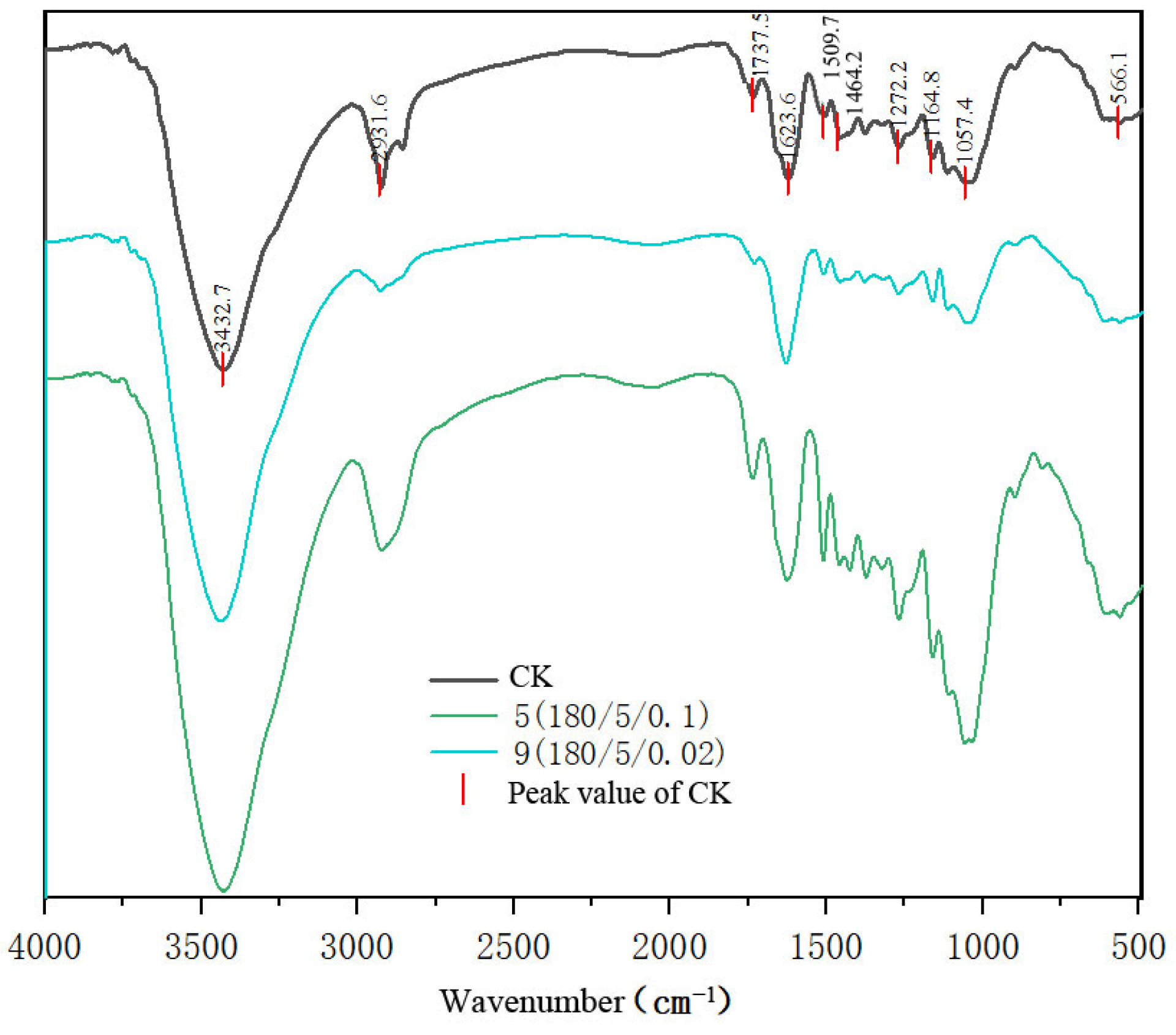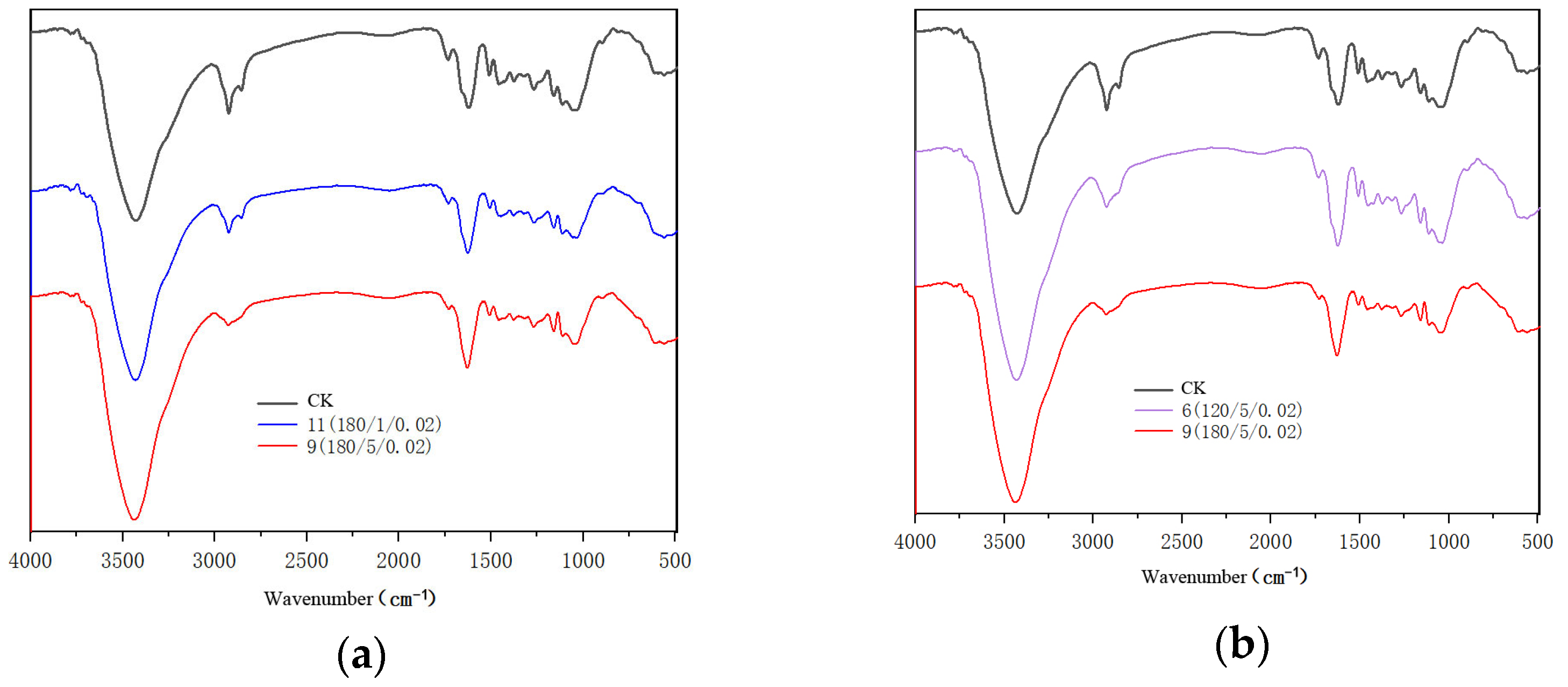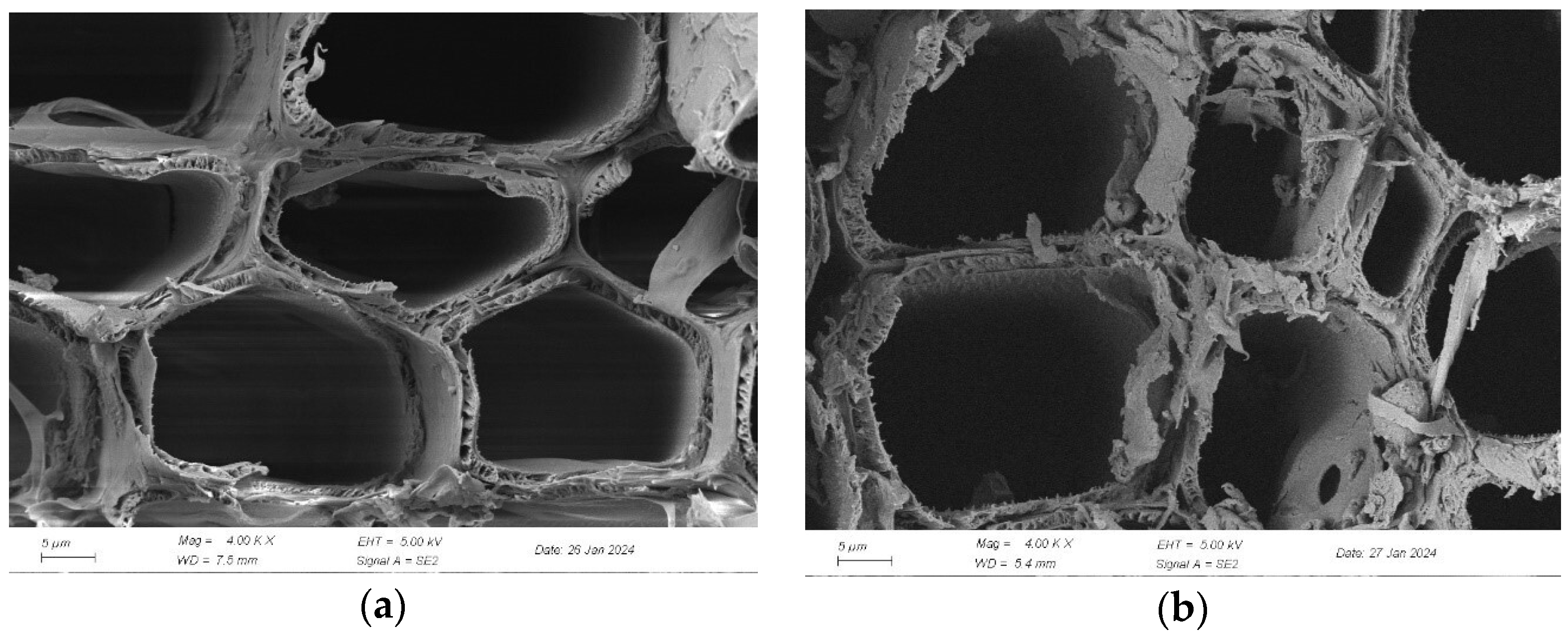Effects of Heat Treatment on the Chemical Composition and Microstructure of Cupressus funebris Endl. Wood
Abstract
:1. Introduction
2. Materials and Methods
2.1. Test Material
2.2. Vacuum Heat Treatment Process
| Factor | Encoding | Level | ||
|---|---|---|---|---|
| Low | High | |||
| Heating Temperature (°C) | H1 | A | 120 | 180 |
| Holding Time (h) | T2 | B | 1 | 5 |
| Vacuum Pressure (MPa) | V3 | C | 0.10 | 0.02 |
| Standard Sequence | Operational Sequence | Heating Temperature (°C) | Holding Time (h) | Vacuum Pressure (MPa) |
|---|---|---|---|---|
| 1 | 1 | 120 | 1 | 0.02 |
| 7 | 2 | 120 | 5 | 0.10 |
| 9 | 3 | 150 | 3 | 0.06 |
| 5 | 4 | 120 | 1 | 0.10 |
| 8 | 5 | 180 | 5 | 0.10 |
| 3 | 6 | 120 | 5 | 0.02 |
| 10 | 7 | 150 | 3 | 0.06 |
| 6 | 8 | 180 | 1 | 0.10 |
| 4 | 9 | 180 | 5 | 0.02 |
| 11 | 10 | 150 | 3 | 0.06 |
| 2 | 11 | 180 | 1 | 0.02 |

2.3. Fourier Transform Infrared Spectroscopy Test
2.4. X-ray Diffraction Test
2.5. Scanning Electron Microscopy Test
3. Results and Discussion
3.1. Fourier Transform Infrared Spectroscopy Analysis
3.2. Crystallinity Analysis of Heat-Treated Cellulose
3.3. Microstructural Analysis of Heat-Treated Wood
4. Conclusions
Author Contributions
Funding
Data Availability Statement
Conflicts of Interest
References
- Wang, L.; Toppinen, A.; Juslin, H. Use of wood in green building: A study of expert perspectives from the UK. J. Clean. Prod. 2014, 65, 350–361. [Google Scholar] [CrossRef]
- Pan, Y. Influence of Different Gap Reconstruction Mode on the Understory Plant and Soil Animal Biodiversity of Low-Efficiency Cypress Forest in Hilly Area of Central Sichuan, China. Master’s Thesis, Sichuan Agricultural University, Ya’an, China, 2014. (In Chinese). [Google Scholar]
- Lyu, Q.; Luo, Y.; Liu, S.Z.; Zhang, Y.; Li, X.J.; Hou, G.R.; Chen, G.; Zhao, K.J.; Fan, C.; Li, X.W. Forest gaps alter the soil bacterial community of weeping cypress plantations by modulating the understory plant diversity. Front. Plant Sci. 2022, 13, 920905. [Google Scholar] [CrossRef] [PubMed]
- Li, D.; Li, X.; Su, Y.; Li, X.; Yin, H.; Li, X.; Guo, M.; He, Y. Forest gaps influence fungal community assembly in a weeping cypress forest. Appl. Microbiol. Biotechnol. 2019, 103, 3215–3224. [Google Scholar] [CrossRef]
- Wagenführ, R.; Scheiber, C. Holzatlas; Fachbuchverlag Leipzig: Munchen, Germany, 1974. [Google Scholar]
- Lyu, J.; Qu, H.; Chen, M. Influence of Wood Knots of Chinese Weeping Cypress on Selected Physical Properties. Forests 2023, 14, 1148. [Google Scholar] [CrossRef]
- Yu, M.; Peng, F.; Xu, G.; Liu, Q.; Fan, X.; Yu, S. Empirical Research on Application of Cupressus funebris Multi-objective Uses in Thousand-isle Lake Scenic Spot. J. Green Sci. Technol. 2013, 5, 138–139. (In Chinese) [Google Scholar] [CrossRef]
- Lyu, J.; Zhao, J.; Xie, J.; Li, X.; Chen, M. Distribution and composition Analysis of Essential Oils Extracted from Different Parts of Cupressus funebris and Juniperus chinensis. BioResources 2018, 13, 5778–5792. [Google Scholar] [CrossRef]
- Esteves, B.; Pereira, H. Wood modification by heat treatment: A review. BioResources 2009, 4, 370–404. [Google Scholar] [CrossRef]
- Xing, D.; Hu, J.; Yao, L. Research review of material prediction and quality control of heat-treated wood. J. Zhejiang A&F Univ. 2020, 37, 793–800. (In Chinese) [Google Scholar] [CrossRef]
- Xu, J.; Zhang, Y.; Shen, Y.; Li, C.; Wang, Y.; Ma, Z.; Sun, W. New Perspective on Wood Thermal Modification: Relevance between the Evolution of Chemical Structure and Physical-Mechanical Properties, and Online Analysis of Release of VOCs. Polymers 2019, 11, 1145. [Google Scholar] [CrossRef]
- Kozakiewicz, P.; Drożdżek, M.; Laskowska, A.; Grześkiewicz, M.; Bytner, O.; Radomski, A.; Mróz, A.; Betlej, I.; Zawadzki, J. Chemical Composition as a Factor Affecting the Mechanical Properties of Thermally Modified Black Poplar (Populus nigra L.). BioResources 2020, 15, 3915–3929. [Google Scholar] [CrossRef]
- Tjeerdsma, B.; Boonstra, M.; Pizzi, A.; Tekely, P.; Militz, H. Characterisation of thermally modified wood: Molecular reasons for wood performance improvement. Holz. Roh. Werkst. 1998, 56, 149. [Google Scholar] [CrossRef]
- Wu, J.Y.; Zhong, T.H.; Zhang, W.F.; Shi, J.J.; Fei, B.H.; Chen, H. Comparison of colors, microstructure, chemical composition and thermal properties of bamboo fibers and parenchyma cells with heat treatment. J. Wood Sci. 2021, 67, 56. [Google Scholar] [CrossRef]
- Wu, Z.; Chen, Y.; Huang, C.; Li, J.; Bao, Y.; Sun, F. A Review of Effects of Heat Treatment on Wood Mechanical Properties. World For. Res. 2019, 32, 59–64. (In Chinese) [Google Scholar] [CrossRef]
- Wang, J.; Lyu, J.; Li, X.; Jiang, Y.; Chen, M. Optimization of parameters for vacuum heat modification of Cupressus funebris wood. BioResources 2023, 18, 5531. [Google Scholar] [CrossRef]
- Zelinka, S.L.; Altgen, M.; Emmerich, L.; Guigo, N.; Keplinger, T.; Kymäläinen, M.; Thybring, E.E.; Thygesen, L.G. Review of Wood Modification and Wood Functionalization Technologies. Forests 2022, 13, 1004. [Google Scholar] [CrossRef]
- Kawamoto, H. Lignin pyrolysis reactions. J. Wood Sci. 2017, 63, 117–132. [Google Scholar] [CrossRef]
- Yang, H.; Yan, R.; Chen, H.; Lee, D.H.; Zheng, C. Characteristics of hemicellulose, cellulose and lignin pyrolysis. Fuel 2007, 86, 1781–1788. [Google Scholar] [CrossRef]
- Barlović, N.; Čavlović, A.O.; Pervan, S.; Klarić, M.; Prekrat, S.; Španić, N. Chemical changes and environmental issues of heat treatment of wood. Drvna Ind. 2022, 73, 245–251. [Google Scholar] [CrossRef]
- Esteves, B.; Ayata, U.; Cruz-Lopes, L.; Brás, I.; Ferreira, J.; Domingos, I. Changes in the content and composition of the extractives in thermally modified tropical hardwoods. Maderas Cienc. Tecnol. 2022, 24, 22. [Google Scholar] [CrossRef]
- Kubovský, I.; Kačíková, D.; Kačík, F. Structural changes of oak wood main components caused by thermal modification. Polymers 2022, 12, 485. [Google Scholar] [CrossRef]
- Wang, D.; Fu, F.; Lin, L. Molecular-level characterization of changes in the mechanical properties of wood in response to thermal treatment. Cellulose 2022, 29, 3131–3142. [Google Scholar] [CrossRef]
- Boonstra, M.J.; Rijsdijk, J.F.; Sander, C.; Kegel, E.; Tjeerdsma, B.; Militz, H.; Acker, J.V.; Stevens, M. Microstructural and physical aspects of heat treated wood. Part 1. Softwoods. Maderas Cienc. Tecnol. 2006, 8, 193–208. [Google Scholar] [CrossRef]
- Di Lena, G.; Sanchez del Pulgar, J.; Lucarini, M.; Durazzo, A.; Ondrejíčková, P.; Oancea, F.; Frincu, R.-M.; Aguzzi, A.; Ferrari Nicoli, S.; Casini, I.; et al. Valorization Potentials of Rapeseed Meal in a Biorefinery Perspective: Focus on Nutritional and Bioactive Components. Molecules 2021, 26, 6787. [Google Scholar] [CrossRef] [PubMed]
- Segal, L.; Creely, J.J.; Martin, A.E.; Conrad, C.M. An Empirical Method for Estimating the Degree of Crystallinity of Native Cellulose Using the X-Ray Diffractometer. Text. Res. J. 1959, 29, 786–794. [Google Scholar] [CrossRef]
- Bhuiyan, R.; Hirai, T.; Sobue, N.N. Effect of intermittent heat treatment on crystallinity in wood cellulose. J. Wood Sci. 2001, 47, 336–341. [Google Scholar] [CrossRef]
- Liang, T.; Wang, L. Thermal treatment of poplar hemicelluloses at 180 to 220 C under nitrogen atmosphere. BioResources 2017, 12, 1128–1135. [Google Scholar] [CrossRef]
- Jiang, X.; Wang, W.; Guo, Y.; Dai, M. Effect of Pressurized Hydrothermal Treatment on the Properties of Cellulose Amorphous Region Based on Molecular Dynamics Simulation. Forests 2023, 14, 1208. [Google Scholar] [CrossRef]
- Chang, H.C.; Zhang, R.L.; Hsu, D.T. The effect of pressure on cation–cellulose interactions in cellulose/ionic liquid mixtures. Phys. Chem. Chem. Phys. 2015, 17, 27573–27578. [Google Scholar] [CrossRef] [PubMed]
- Shen, Y.; Gao, Z.; Hou, X.; Chen, Z.; Jiang, J.; Sun, J. Spectral and thermal analysis of Eucalyptus wood drying at different temperature and methods. Drying Technol. 2019, 38, 313–320. [Google Scholar] [CrossRef]
- Cheng, S.; Huang, A.; Wang, S.; Zhang, Q. Effect of Different Heat Treatment Temperatures on the Chemical Composition and Structure of Chinese Fir Wood. BioResources 2016, 11, 4006–4016. [Google Scholar] [CrossRef]
- Zhang, J. Physical and Mechanical Properties and Thermal Degradation Characteristics of Heat-Treated Chinese Fir. Master’s Thesis, Beijing Forestry University, Beijing, China, 2021. (In Chinese) [Google Scholar] [CrossRef]
- He, Z.; Qi, Y.; Zhang, G.; Zhao, Y.; Dai, Y.; Liu, B.; Lian, C.; Dong, X.; Li, Y. Mechanical Properties and Dimensional Stability of Poplar Wood Modified by Pre-Compression and Post-Vacuum-Thermo Treatments. Polymers 2022, 14, 1571. [Google Scholar] [CrossRef] [PubMed]
- Gao, Y.; Zhou, Y.; Fu, Z.; Van Den Bulcke, J.; Van Acker, J. Swelling behavior of thermally modified timber from a cellular and chemical perspective. Holzforschung 2023, 77, 713–723. [Google Scholar] [CrossRef]
- Brosse, N.; Hage, R.E.I.; Chaouch, M.; Pétrissans, M.; Dumarçay, S.; Gérardin, P. Investigation of the chemical modifications of beech wood lignin during heat treatment. Polym. Degrad. Stab. 2010, 95, 1721–1726. [Google Scholar] [CrossRef]
- Birinci, E.; Karamanoğlu, M.; Kesik, H.İ.; Kaymakci, A. Effect of heat treatment parameters on the physical, mechanical, and crystallinity index properties of Scots pine and beech wood. BioResources 2022, 17, 4713–4729. [Google Scholar] [CrossRef]
- Zauer, M.; Meissner, F.; Plagge, R.; Wagenführ, A. Capillary pore-size distribution and equilibrium moisture content of wood determined by means of pressure plate technique. Holzforschung 2016, 70, 137–143. [Google Scholar] [CrossRef]
- Lengowski, E.C.; Bonfatti Júnior, E.A.; Nisgoski, S.; Bolzon de Muñiz, G.I.; Klock, U. Properties of thermally modified teakwood. Maderas Cienc. Tecnol. 2021, 23, 10. [Google Scholar] [CrossRef]
- Cademartori, P.H.G.; dos Santos, P.S.B.; Serrano, L.; Labidi, J.; Gatto, D.A. Effect of thermal treatment on physicochemical properties of gympie messmate wood. Ind. Crop Prod. 2013, 45, 360–366. [Google Scholar] [CrossRef]
- Mecca, M.; D’Auria, M.; Todaro, L. Effect of heat treatment on wood chemical composition, extraction yield and quality of the extractives of some wood species by the use of molybdenum catalysts. Wood Sci. Technol. 2019, 53, 119–133. [Google Scholar] [CrossRef]
- Phuong, L.X.; Shida, S.; Saito, Y. Effects of heat treatment on brittleness of Styrax tonkinensis wood. J. Wood Sci. 2007, 53, 181–186. [Google Scholar] [CrossRef]







| Process Conditions | I002 | Iam | Crystallization Index | Relative Crystallization Index |
|---|---|---|---|---|
| Untreated group | 19,793.06 | 12,200.68 | 38.36 | 100 |
| 120 °C/5 h/0.1 MPa | 20,227.44 | 11,886.3 | 41.24 | 107.50 |
| 180 °C/5 h/0.1 M Pa | 22,941.49 | 13,317.8 | 41.95 | 109.36 |
| 120 °C/5 h/0.02 MPa | 23,425.59 | 12,966.84 | 44.65 | 116.39 |
| 180 °C/1 h/0.1 MPa | 20,144.46 | 11,579.86 | 42.52 | 110.84 |
| 180 °C/5 h/0.02 MPa | 18,621.11 | 11,302.88 | 39.30 | 102.46 |
| 180 °C/1 h/0.02 MPa | 18,318.12 | 11,067.17 | 39.58 | 103.19 |
Disclaimer/Publisher’s Note: The statements, opinions and data contained in all publications are solely those of the individual author(s) and contributor(s) and not of MDPI and/or the editor(s). MDPI and/or the editor(s) disclaim responsibility for any injury to people or property resulting from any ideas, methods, instructions or products referred to in the content. |
© 2024 by the authors. Licensee MDPI, Basel, Switzerland. This article is an open access article distributed under the terms and conditions of the Creative Commons Attribution (CC BY) license (https://creativecommons.org/licenses/by/4.0/).
Share and Cite
Lyu, J.; Wang, J.; Chen, M. Effects of Heat Treatment on the Chemical Composition and Microstructure of Cupressus funebris Endl. Wood. Forests 2024, 15, 1370. https://doi.org/10.3390/f15081370
Lyu J, Wang J, Chen M. Effects of Heat Treatment on the Chemical Composition and Microstructure of Cupressus funebris Endl. Wood. Forests. 2024; 15(8):1370. https://doi.org/10.3390/f15081370
Chicago/Turabian StyleLyu, Jianhua, Jialei Wang, and Ming Chen. 2024. "Effects of Heat Treatment on the Chemical Composition and Microstructure of Cupressus funebris Endl. Wood" Forests 15, no. 8: 1370. https://doi.org/10.3390/f15081370






